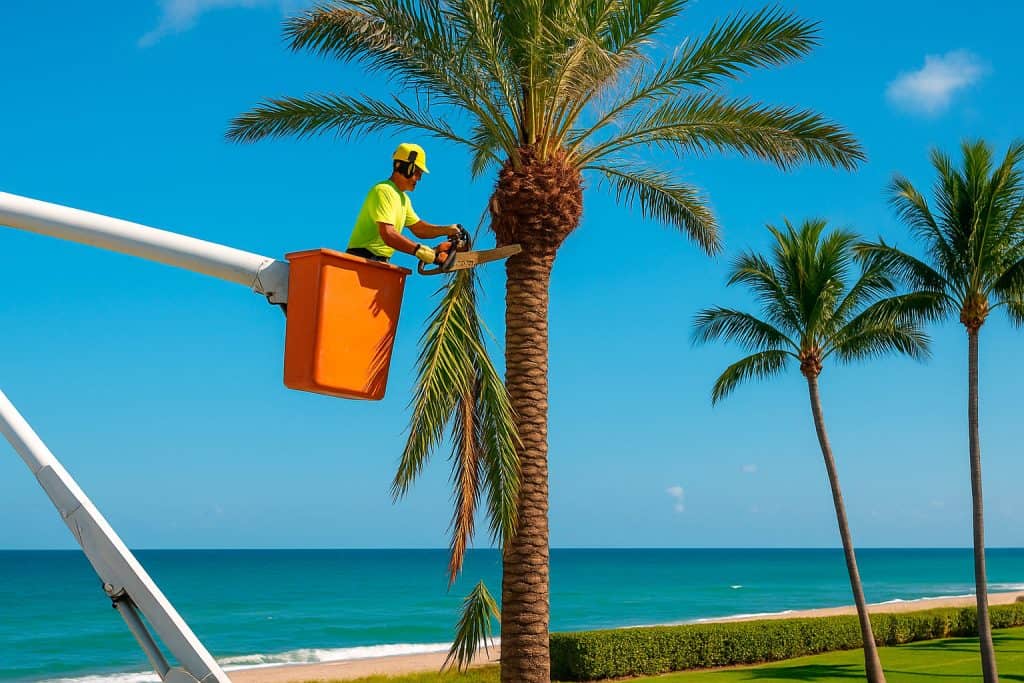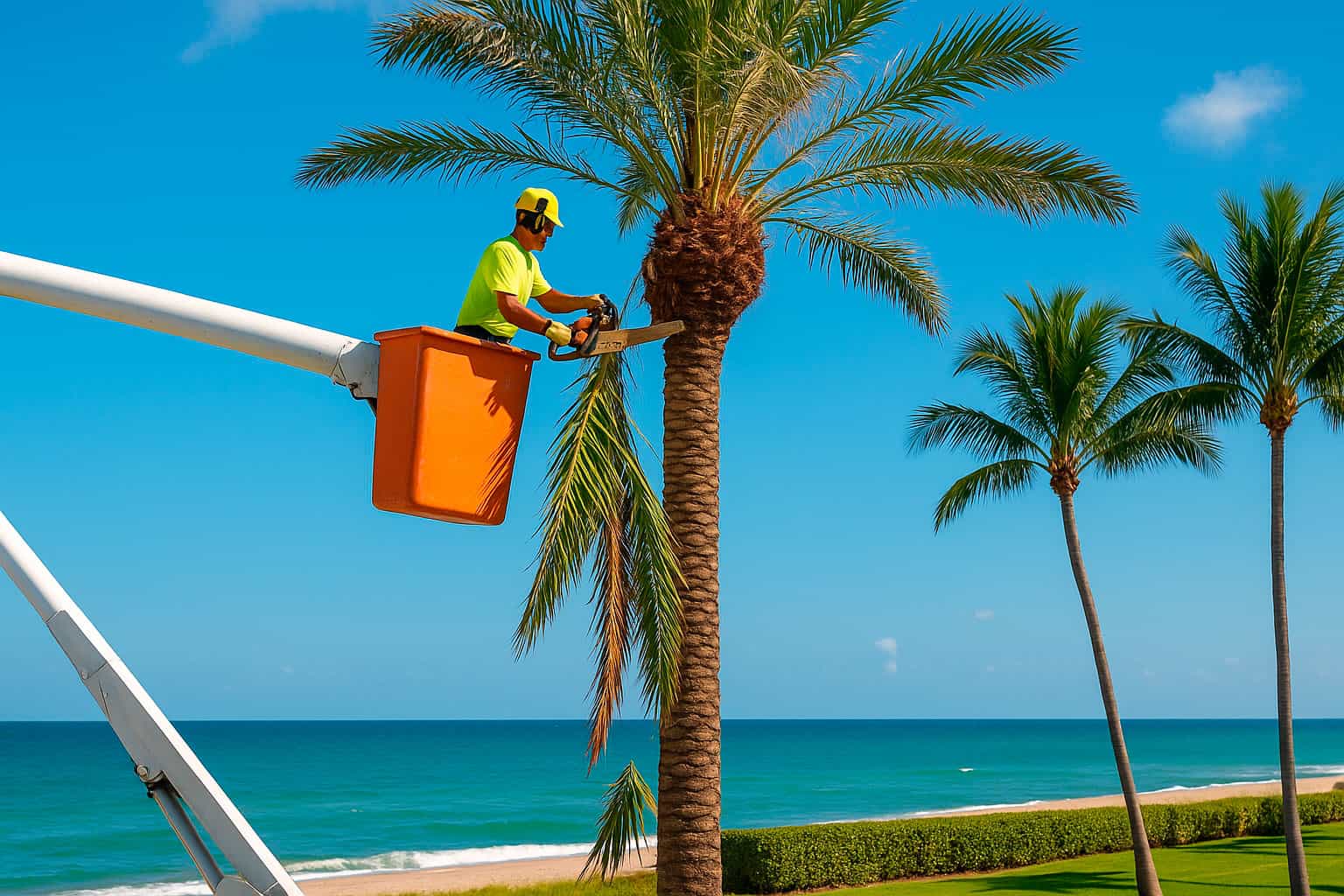Palm trees stand as proud symbols of Palm Beach’s beauty, but many property owners struggle with proper care. Dead fronds, pest problems, and storm damage create eyesores that hurt curb appeal.
Poor trimming practices often lead to weak trees that can’t handle Florida’s tough weather, putting properties at risk during hurricane season.
These majestic plants need special care because they’re not true trees at all. Palm trees grow more like giant grasses, which means they can’t heal from damage like regular trees do.
One wrong cut can harm them forever.
We’ll show you the right ways to trim and care for your palms in Palm Beach. You’ll learn proven methods for removing dead fronds, proper fertilizing tips, and smart watering practices that keep palms healthy.
Ready to make your palm trees thrive? Keep reading for expert guidance that works.

Key Takeaways
- Palm trees need 1 inch of water weekly, with new plantings requiring daily watering for six months. After that, water three times weekly during warm months and monthly in cooler periods.
- Remove only dead or dying fronds, keeping healthy ones between 9 and 3 o’clock positions. Never cut more than 25% of fronds at once to protect the tree’s health.
- Use slow-release fertilizers with a 2N:3K ratio 4-5 times yearly. Apply them 2 feet away from the trunk. New palms should wait 3-4 months before their first feeding.
- Clean tools with bleach solution between cuts to stop diseases like Fusarium wilt. This deadly disease mainly affects Fan, Queen, and Canary Island palms.
- Avoid “hurricane cutting” that strips most fronds. This harsh practice weakens palms and leads to disease. Use a soil mix with 30-50% sand and 2-inch mulch layer for proper drainage.
Best Practices for Palm Tree Trimming
Proper palm tree trimming needs expert knowledge and the right tools to keep your trees healthy. Your palm trees will stay strong through storms and diseases with regular care from certified arborists who know the correct pruning methods.
Remove only dead or dying fronds
Dead palm fronds create risks for your commercial property in Palm Beach. These brown, lifeless leaves must be removed right away to stop injuries from falling debris. Your palm trees need careful attention to stay strong and healthy.
Removing dead fronds helps prevent damage during storms while keeping your property safe and attractive.
Cutting off living, green fronds will harm your palms and reduce their energy production. The right pruning method keeps fronds between the 9 and 3 o’clock positions on the tree’s canopy.
Yellow lower fronds still give nutrients to the palm, so leave them in place. A healthy palm shows a round, semi-circular shape with the right number of fronds intact. Smart pruning limits cuts to no more than 25% of healthy fronds to protect against disease and stress.
Avoid excessive pruning or “hurricane cutting”
Excessive palm pruning, often called “hurricane cutting,” causes serious harm to palm trees in Palm Beach. This harsh trimming method strips away most or all fronds, leaving the tree weak and open to disease.
The practice creates many open wounds on the palm, making it easier for fungal pathogens to attack the tree. Proper palm tree care needs a gentle touch that keeps the natural shape intact.
The removal of too many green fronds stops the palm from making food through photosynthesis. This lack of nutrients leads to palm stress and shorter lifespans for valuable landscape assets.
Commercial properties need healthy palms that can stand strong against storms without extreme cutting. Smart pruning focuses only on dead or dying fronds while protecting the terminal bud from damage.
Your palm trees will stay beautiful and strong with the right care approach.
Use sanitized tools to prevent disease spread
Clean tools play a vital role in palm tree care. Professional landscapers must sanitize their pruning equipment with bleach-water solutions before each cut. This practice stops harmful diseases like Fusarium wilt from spreading between palm trees in your commercial space.
Your palm trees need protection from dangerous pathogens during maintenance work. Proper tool cleaning between cuts blocks disease transmission to other palms and landscape plants.
Many cheap services skip this crucial step, putting your entire landscape at risk. Smart business owners choose services that follow strict tool sanitization rules to keep their palm trees healthy.
Essential Care Tips for Palm Trees
Palm trees need specific care to stay healthy in Palm Beach’s unique climate. Your palm trees will thrive with the right mix of water, fertilizer, and pest control from a certified arborist.
Use slow-release, palm-specific fertilizers
Proper fertilization stands as a crucial part of palm tree care in commercial landscapes. Your palm trees need special slow-release fertilizers with a 2N:3K ratio, rich in potassium, magnesium, manganese, and boron.
These nutrients must be applied 2 feet away from the trunk to protect the root system from damage.
Smart fertilizer timing makes a big difference in palm health and growth. Established palms need feeding 4 to 5 times yearly during growing seasons, while new plantings should wait 3 to 4 months before their first fertilizer application.
The right slow-release granules prevent long-term nutrient problems that could harm your palm trees’ health. Missing nutrients can take up to three years to fix, making regular feeding with the correct palm-specific formula essential for your landscape’s success.
Ensure proper watering during dry periods
Palm trees need specific water amounts to stay healthy in Palm Beach’s dry periods. Your commercial palm trees require one inch of water weekly, with careful checks of soil moisture before each watering session.
Morning watering works best for these trees, letting leaves dry naturally and cutting down disease risks. Deep watering creates strong root systems that help palms survive tough weather.
Smart watering schedules change with the seasons in Florida’s climate. Water new palm plantings daily for six months, then cut back to three times weekly. During warm months, water twice monthly, scaling back to once monthly in cooler times.
Yellow or wilting leaves signal too much water, which leads to root rot. A soil mix with 30 to 50 percent sand helps water drain well, while a 2-inch mulch layer keeps moisture locked in the soil.
Monitor for pests and diseases regularly
Regular pest checks protect your commercial palm trees from costly damage. Scale insects, spider mites, and aphids need quick action at the first sign of trouble. Yellow fronds and strange growth patterns signal early pest problems.
Summer brings higher risks of fungal and bacterial diseases, making frequent inspections vital for your property’s greenery.
Dead fronds create fire risks and perfect homes for harmful bugs in your landscape. Your trees need careful checks for Fusarium wilt, a deadly disease that attacks Fan, Queen, and Canary Island palms.
Clear signs like wilting or odd colors mean your trees need expert care right away. Quick treatment through palm injections stops diseases from spreading across your grounds.
Conclusion
Proper palm tree care stands as a vital part of property maintenance in Palm Beach. Professional trimming keeps palms strong against storms while making them look great. Your palm trees need expert care through correct pruning methods, right fertilizers, and careful pest control.
Smart palm care brings lasting benefits to both commercial spaces and the local environment.
FAQs
1. How often should palm trees be pruned in Palm Beach?
Palm trees need pruning once or twice per year. Dead fronds and coconut palms require more frequent care to prevent tree stress and maintain soil health.
2. What are signs my palm tree needs professional care?
Look for leaf spots, nutrient deficiencies, or heavy seed leaf growth. A certified arborist can spot these issues during proper tree maintenance checks.
3. Which palm species grow best in Palm Beach areas?
Sabal palmetto, royal palm, and queen palm thrive in West Palm Beach, Delray Beach, and Boca Raton. These species handle local soil composition and hurricanes well.
4. Should I remove weeds around my palm trees?
Yes, weeds compete with palm trees for nourishment and can harm beneficial organisms in the ecosystem. Regular weed control helps maintain healthy lawns and palm growth.
5. What’s the best way to protect palm trees during storms?
Proper pruning before hurricane season helps prevent tree stress and damage. Remove dead fronds and ensure the tree has strong roots through good soil health practices.
6. Is tree topping good for palm trees?
No, tree topping harms palm trees and disrupts their natural growth pattern. This practice can lead to serious tree stress and eventual tree removal needs.




 Working Hours:
Working Hours:
